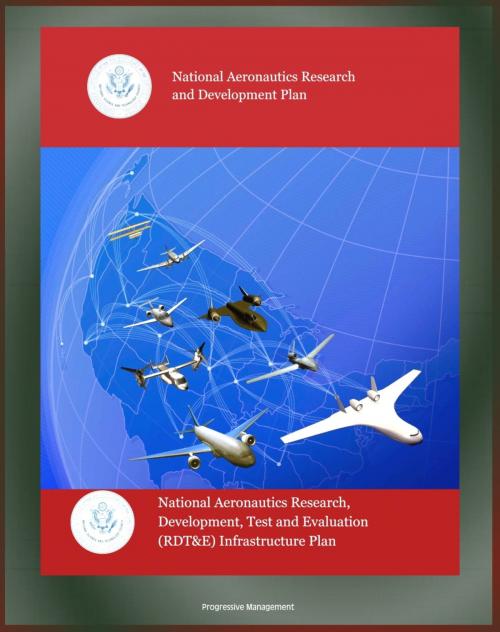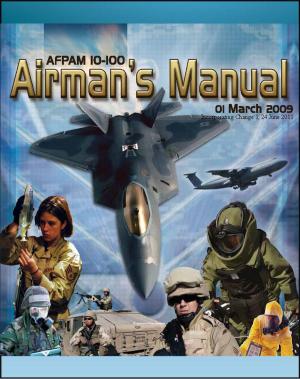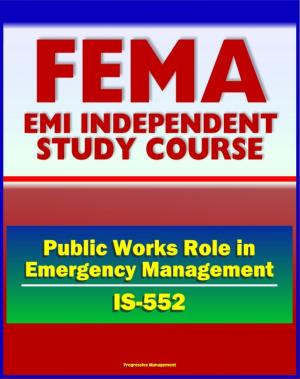National Aeronautics Research and Development Plan and Development, Test and Evaluation (RDT&E) Infrastructure Plan - Air Traffic, Unmanned Aircraft Systems (UAS), NAS, Hypersonic Flight, Safety
Nonfiction, Reference & Language, Transportation, Aviation, Commercial, Science & Nature, Technology, Aeronautics & Astronautics| Author: | Progressive Management | ISBN: | 9781476218625 |
| Publisher: | Progressive Management | Publication: | July 18, 2012 |
| Imprint: | Smashwords Edition | Language: | English |
| Author: | Progressive Management |
| ISBN: | 9781476218625 |
| Publisher: | Progressive Management |
| Publication: | July 18, 2012 |
| Imprint: | Smashwords Edition |
| Language: | English |
To meet the aviation needs of our Nation now and in the future, the Federal government must continue to advance U.S. technological leadership in aeronautics by fostering a vibrant and dynamic aeronautics community that includes government, industry, and academia. A strong national program of research and development (R&D) for aeronautics technology forms the foundation of the U.S. aeronautics and aviation enterprise. Aeronautics R&D is critical for national security and homeland defense, an efficient national air transportation system, and the economic well-being and quality of life of our citizens.
This National Aeronautics Research and Development Plan (Plan) lays out high-priority national aeronautics R&D challenges, goals, and supporting objectives to guide the conduct of U.S. aeronautics R&D activities through 2020 as called for by Executive Order 13419 (National Aeronautics R&D), which established the National Aeronautics R&D Policy.
Research and Development Plan Contents: Organizational Progress * Intra-Agency Research * Interagency and Collaborative Research * Mobility Through the Air Is Vital to Economic Stability, Growth, and Security as a Nation * Introduction * State of the Art * Fundamental Mobility Challenges to Overcome * Mobility R&D Goals and Objectives * Goal 1—Develop Reduced Aircraft Separation in Trajectory- and Performance-Based Operations * Goal 2—Develop Increased NAS Capacity by Managing NAS Resources and Air Traffic Flow Contingencies * Goal 3—Reduce the Adverse Impacts of Weather on Air Traffic Management Decisions * Goal 4—Maximize Arrivals and Departures at Airports and in Metroplex Areas * Goal 5—Develop Expanded Manned and Unmanned Aircraft System Capabilities to Take Advantage of Increased Air Transportation System Performance * Aviation Is Vital to National Security and Homeland Defense * Introduction * State of the Art * Fundamental Technical Challenges to Overcome * National Security and Homeland Defense R&D Goals and Objectives * Goal 1—Demonstrate Increased Cruise Lift-to-Drag and Innovative Airframe Structural Concepts for Highly Efficient High-Altitude Flight and for Mobility Aircraft * Goal 2—Develop Improved Lift, Range, and Mission Capability for Rotorcraft * Goal 3—Demonstrate Reduced Gas Turbine Specific Fuel Consumption * Goal 4—Demonstrate Increased Power Generation and Thermal Management Capacity for Aircraft * Goal 5—Demonstrate Sustained, Controlled, Hypersonic Flight * Goal 6—Develop Capabilities for UAS NAS Integration * Aviation Safety Is Paramount * Introduction * State of the Art * Fundamental Safety Challenges to Overcome * Aviation Safety R&D Goals and Objectives * Goal 1—Develop Technologies to Reduce Accidents and Incidents Through Enhanced Vehicle Design, Structure, and Subsystems * Goal 2—Develop Technologies, for Manned and Unmanned Systems, to Reduce Accidents and Incidents Through Enhanced Aerospace Vehicle Operations on the Ground and in the Air * Goal 3—Demonstrate Enhanced Passenger and Crew Survivability in the Event of an Accident * Assuring Energy Availability and Efficiency Is Central to the Growth of the Aeronautics Enterprise, and the Environment Must Be Protected While Sustaining Growth in Air Transportation * State of the Art * Fundamental Energy and Environmental Challenges to Overcome * Energy and Environment R&D Goals and Objectives * Goal 1—Enable New Aviation Fuels Derived from Diverse and Domestic Resources to Improve Fuel Supply Security and Price Stability
To meet the aviation needs of our Nation now and in the future, the Federal government must continue to advance U.S. technological leadership in aeronautics by fostering a vibrant and dynamic aeronautics community that includes government, industry, and academia. A strong national program of research and development (R&D) for aeronautics technology forms the foundation of the U.S. aeronautics and aviation enterprise. Aeronautics R&D is critical for national security and homeland defense, an efficient national air transportation system, and the economic well-being and quality of life of our citizens.
This National Aeronautics Research and Development Plan (Plan) lays out high-priority national aeronautics R&D challenges, goals, and supporting objectives to guide the conduct of U.S. aeronautics R&D activities through 2020 as called for by Executive Order 13419 (National Aeronautics R&D), which established the National Aeronautics R&D Policy.
Research and Development Plan Contents: Organizational Progress * Intra-Agency Research * Interagency and Collaborative Research * Mobility Through the Air Is Vital to Economic Stability, Growth, and Security as a Nation * Introduction * State of the Art * Fundamental Mobility Challenges to Overcome * Mobility R&D Goals and Objectives * Goal 1—Develop Reduced Aircraft Separation in Trajectory- and Performance-Based Operations * Goal 2—Develop Increased NAS Capacity by Managing NAS Resources and Air Traffic Flow Contingencies * Goal 3—Reduce the Adverse Impacts of Weather on Air Traffic Management Decisions * Goal 4—Maximize Arrivals and Departures at Airports and in Metroplex Areas * Goal 5—Develop Expanded Manned and Unmanned Aircraft System Capabilities to Take Advantage of Increased Air Transportation System Performance * Aviation Is Vital to National Security and Homeland Defense * Introduction * State of the Art * Fundamental Technical Challenges to Overcome * National Security and Homeland Defense R&D Goals and Objectives * Goal 1—Demonstrate Increased Cruise Lift-to-Drag and Innovative Airframe Structural Concepts for Highly Efficient High-Altitude Flight and for Mobility Aircraft * Goal 2—Develop Improved Lift, Range, and Mission Capability for Rotorcraft * Goal 3—Demonstrate Reduced Gas Turbine Specific Fuel Consumption * Goal 4—Demonstrate Increased Power Generation and Thermal Management Capacity for Aircraft * Goal 5—Demonstrate Sustained, Controlled, Hypersonic Flight * Goal 6—Develop Capabilities for UAS NAS Integration * Aviation Safety Is Paramount * Introduction * State of the Art * Fundamental Safety Challenges to Overcome * Aviation Safety R&D Goals and Objectives * Goal 1—Develop Technologies to Reduce Accidents and Incidents Through Enhanced Vehicle Design, Structure, and Subsystems * Goal 2—Develop Technologies, for Manned and Unmanned Systems, to Reduce Accidents and Incidents Through Enhanced Aerospace Vehicle Operations on the Ground and in the Air * Goal 3—Demonstrate Enhanced Passenger and Crew Survivability in the Event of an Accident * Assuring Energy Availability and Efficiency Is Central to the Growth of the Aeronautics Enterprise, and the Environment Must Be Protected While Sustaining Growth in Air Transportation * State of the Art * Fundamental Energy and Environmental Challenges to Overcome * Energy and Environment R&D Goals and Objectives * Goal 1—Enable New Aviation Fuels Derived from Diverse and Domestic Resources to Improve Fuel Supply Security and Price Stability















